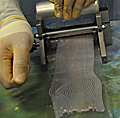Doctors uniformly agree that heart valves recovered from donor cadavers can save lives where mechanical valves or those from pig or cow do not help. Recovered corneas can restore sight. And recovered human skin can serve as an optimal dressing for severe burn injuries.
The benefits, however, aren’t so clear when discussion turns to musculoskeletal tissues.
In Germany, a country renowned for having one of the best health care systems in the world, surgeons use bone, tendon or fascia implants less often than their U.S colleagues.
Take abdominal surgery, for example. In the United States, among other products, mesh made of recovered human skin is used for hernia repairs. German surgeons prefer synthetic mesh.
“For my area of expertise, nothing would be missing if the human tissue industry did not exist,” said Hans-Joachim Meyer, General Secretary of the German Society of Surgery. “Based on our current knowledge, those (synthetic, MK) meshes bring the best results, under the aspect of tolerability and long term outcome.”
It is a similar story in the area of sports medicine. In the U.S., it is estimated that about 25 percent of ruptured Anterior Cruciate Ligaments (ACL) are reconstructed with a cadaveric part, according to Daniel Solomon, a spokesman for the American Academy of Orthopedic Surgeons.
Solomon said it is a good option for patients over age 40.
But in Germany ACL repairs only rarely use donor tissue – known as an allograft – regardless of age. Surgeons prefer to take replacement tendon tissue from the patient, explained Christoph Josten, president of the German Society of Emergency Surgery.
Tissue taken from the patient himself is known as an autograft. An analysis of nine medical studies comparing both methods failed to show any significant benefits of one method over the other.
Josten said he prefers to use one’s own tissue. “For younger people, because of the quality of the reconstruction, we prefer autografts,” he said. “We only make use of allografts when all other options have been exhausted.”
Josten said if he was a patient he would “prefer an autograft.”
Oliver Dierk the treating doctor for German Olympic athletes, and a former team physician of the German premier league soccer club Hamburger SV said he had never used a cadaveric tissue to repair an ACL.
“Autologous material has distinct advantages: it is not rejected by the body and poses no risk of infection,” he said.
Alloderm, a product derived from donated human skin made by the U.S. firm Lifecell, is used for breast reconstruction after cancer. In Germany however Lifecell distributes its porcine (pig) dermis called Strattice, which can also be used for breast reconstruction.
“The results are comparable,” said Peter Vogt, president of the German Society for Plastic, Reconstructive and Aesthetic surgery.
Cadaveric material is less frequently used for plastic surgery in Germany than in the US. “We prefer instead autologous material that can be derived from the patient with minor scars,” said Vogt.
Do German patients therefore receive poorer care than their fellow sufferers in the U.S.?
“On the contrary,” Vogt said. “If we had evidence that allografts were better we would use them too.”
Why then are U.S. surgeons so keen to use allografts? Money may play a role, said American Academy of Orthopedic Surgeons spokesman Daniel Solomon. “With allografts the ACL-reconstruction can be done quicker. There are a number of people who try to do as much surgeries as possible.”
![]() Subscribe to The ICIJ Global Muckraker by email or get the RSS feed
Subscribe to The ICIJ Global Muckraker by email or get the RSS feed

